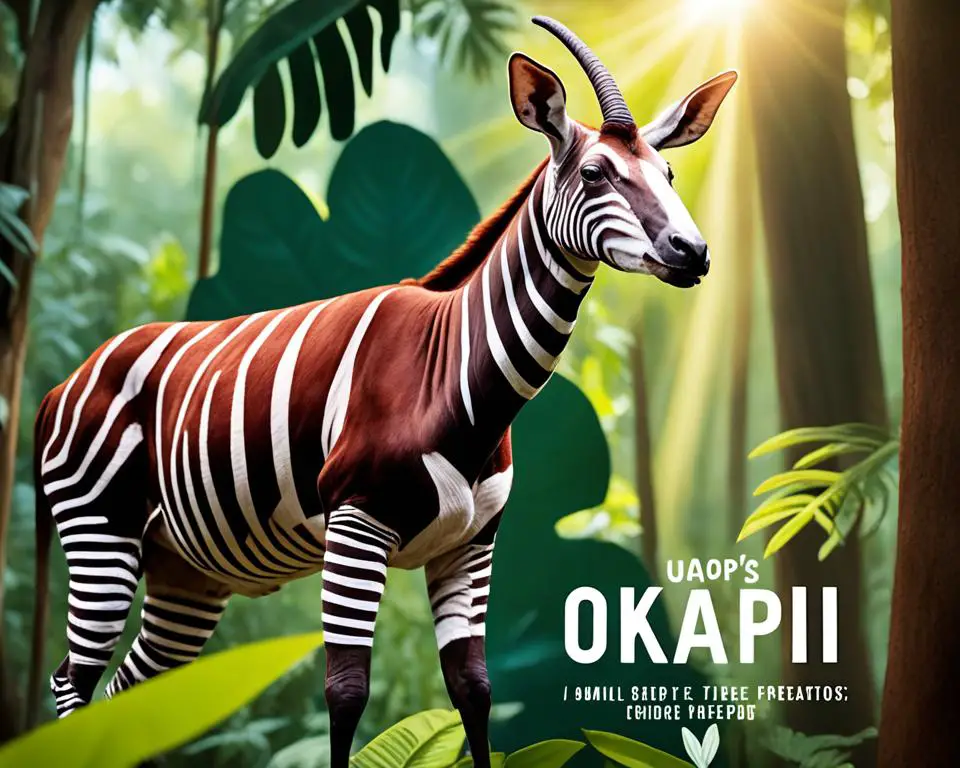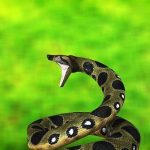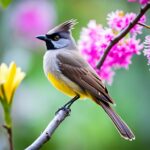Imagine treading through the dense foliage of a rainforest, where creatures great and small embody the wild’s mystery. Among them lurks the okapi, the elusive “forest giraffe,” a secretive creature that glides like a shadow amidst the green. Intriguingly uncommon, these remarkable animals are the whispers of the forest—few have had the privilege of witnessing their splendor beyond the walls of select zoos worldwide.
Peek into the world of okapi facts, where each individual boasts unique features that separate it from the more recognized menagerie of the animal kingdom. Their zebra-like stripes may betray a distant cousinship, but these forest-dwellers share a closer lineage to giraffes, delighting biologists and wildlife enthusiasts alike. You’re about to embark on a journey into the habitat of these secretive creatures, where every leafy path leads to astonishment and every revelation another gem of the natural world.
The Enigmatic Heritage of Okapis
As you delve into the lineage of the okapi, you may find yourself captivated by the evolutionary tale that unfolds. These intriguing creatures boast a rich heritage, marked by both distinction and commonality within the mammalian evolutionary tree. Let’s uncover the okapi’s surprising genetic linkages and ancient roots that make it a subject of continual fascination.
Surprising Kinship with Giraffes
Though their physical presentation may suggest otherwise, the family Giraffidae unites okapis and giraffes as close relatives. Belonging to different taxonomic orders, okapis are members of the even-toed ungulates—a group that includes varieties of hoofed mammals. Despite their contrasting habitats and divergent appearances, key morphological features such as the male’s ossicones and their hallmark prehensile tongues highlight the family resemblance and functional similarities shared with their towering kin.
Resemblance to Zebras: A Visual Mislead
At first glance, you might mistake the okapi for being kin to the zebra, with their vividly striped legs conjuring images of the African savannah. However, this resemblance is but a trick of nature, a visual mislead that aligns them more with an artist’s canvas than with the genealogy of their supposed striped cousins. Indeed, the taxonomic orders place okapis and zebras worlds apart in the ungulate family tree, with the former species reveling in their unique classification within the animal kingdom.
Survivors from an Ancient Lineage
The lineage of the okapi traces back roughly 11.5 million years, connecting them to their common ancestors who once roamed the ancient landscapes of the early Miocene epoch. This deep evolutionary past sets okapis apart as the only current survivors of early hoofed mammals, standing as a living testament to a lineage that once held diverse forms within the undergrowth of history’s dense forests.
With their elusiveness in the wild, the enigmatic okapi continues to pique the curiosity of scientists and animal lovers alike, prompting an enduring dialogue about their place in the natural world. Understandably, such creatures serve not only as symbols of biodiversity’s richness but also as reminders of the persistent threads that link present life forms to their distant, prehistoric forebears.
Unveiling the Okapi’s Unique Striped Pattern
At the heart of the okapi’s mysterious allure lies its strikingly patterned limbs, adorned with enigmatic “follow me” stripes. You may wonder why an animal, seeking to remain unseen, would choose such bold legwear. The answer reflects the remarkable ingenuity of evolution, as these stripes offer an ingenious solution to life in the shade-dappled rainforest. They are not simply a fashion statement; they are a survival mechanism, honed over millennia.
Your journey through the dense understory of the rainforest would be incomplete without a revelation of how the okapi’s camouflage melds into the fragmented light of its habitat. Let’s explore how this distinctive design plays a pivotal role in the day-to-day existence of the okapi, serving as both a disguise against predators and as a critical tool for social cohesion within their elusive herds.
Camouflage Mastery: In the vast green tapestry of a rainforest, the dark backdrop interspersed with streaks of light becomes a canvas for the okapi’s survival. Its leg stripes disrupt the animal’s outline—vital for an individual identification on the forest floor, allowing it to virtually disappear amidst the surrounding foliage and dappled sunlight.
“Follow Me” Stripes: Observing a mother okapi through the dense flora, one can’t help but be intrigued by how her calf maneuvers the labyrinth of vegetation with apparent ease. This is where the “follow me” stripes exhibit their secondary function, guiding the young with a visually compelling pattern that ensures they won’t lose sight of their guardian in the complex rainforest terrain.
- The stripes act as a beacon for the young, ensuring they stay close to their mother.
- Each okapi’s stripe pattern is as unique as a fingerprint, enabling them to recognize one another.
Indeed, the stripes of the okapi are a marvel of nature—a dual-purpose feature that highlights the nuanced interplay between camouflage, individual identification, and the nurturing bonds within okapi families. These remarkable adaptations are not just visually arresting; they are indicative of the deep intelligence woven into the fabric of life in the rainforest.
The Okapi’s Specialized Rainforest Habitat
Within the depths of the Democratic Republic of Congo’s closed canopy forests, the okapi finds its refuge. These hushed, high-humidity enclaves provide a perfect tapestry of light and shadow for these subtle giants. As you journey deeper into their world, you begin to understand the exquisite rainforest adaptations that enable the okapi to thrive in such a specialized habitat.
Adapted to Dense Forests and Dappled Light
Evolution has gifted the okapi with an exceptional ability to navigate and blend into the complexities of the Ituri Forest. In this place of perpetual twilight, the okapi has mastered the art of becoming one with the environment, a trait essential for foraging and avoiding predators. Let’s traverse the dense understory, where the okapi’s adaptations to the dappled light of the rainforest come to life.
Their distinctive striped pattern functions as perfect natural camouflage, breaking up their outline amongst the sun-flecked foliage and underbrush. Such ingenious rainforest adaptation is not merely for eluding the thickness of flora but also for sidestepping a predator’s line of sight. With each quiet step, the okapi demonstrates its unspoken harmony with the dense, living tapestry that it calls home.
Exclusive Range Within the Democratic Republic of Congo
The okapi’s habitat is not widespread; it is a tale of exclusivity, nestled within the Ituri Forest’s precise environmental blueprint. As you explore further, you realize that the okapi’s presence is a silent testament to the ecological richness and seclusion needed for their existence. They steer clear of the peripheries that edge closer to human touch, seeking the serenity of older rainforests where the canopy closes above, creating a world apart from the savannas and disturbed habitats on the outskirts of civilization.
An emphasis on conservation efforts to protect these rainforest sanctuaries becomes apparent, because the okapi does not roam without bounds. Their dependence on this specific stretch of habitat, which remains unfragmented by human settlements, is a poignant reminder of the delicate balance between wildlife and the world at large. To safeguard the future of the okapi, it becomes imperative to preserve the integrity of the closed canopy forests that nurture them.
In these secluded corners of the earth, you bear witness to a living relic of the ancient past— a creature whose very existence is as much a part of the rainforest as the trees that tower above. If you listen closely, the whisper of leaves might just reveal the secrets of the okapi habitat, a realm where adaptation and elusiveness combine to write the narrative of survival.
Understanding the Okapi’s Velvety and Oil-Secreting Fur
As you explore the enchanting world of the okapi, you’ll notice a distinctive feature immediately catching your eye—their fur. This isn’t just any coat; the okapi’s fur is a masterpiece of rainforest adaptation, where every detail serves a purpose. Feel the plushness of their dark purple to reddish-brown velvety fur, and you’re touching centuries of evolutionary ingenuity, a luxurious exterior that pampers the skin while serving as a critical survival tool.
Their glossy coat whispers secrets of ingenious grooming habits and unveils a marvel of the natural world: waterproof fur. Yes, the okapi’s skin secretes a natural oil, creating a waterproof barrier that is as practical as it is extraordinary, allowing these surreptitious creatures to slip through their damp habitat as smoothly as water glides off a duck’s back.
Imagine the hands-on experience of zookeepers during grooming habits; the residue left behind, a testament to the okapi’s well-oiled mechanism intended for the persistent rains of its rainforest home. Such an adaptation is essential for staying dry and healthy in an ecosystem where moisture is as omnipresent as the trees.
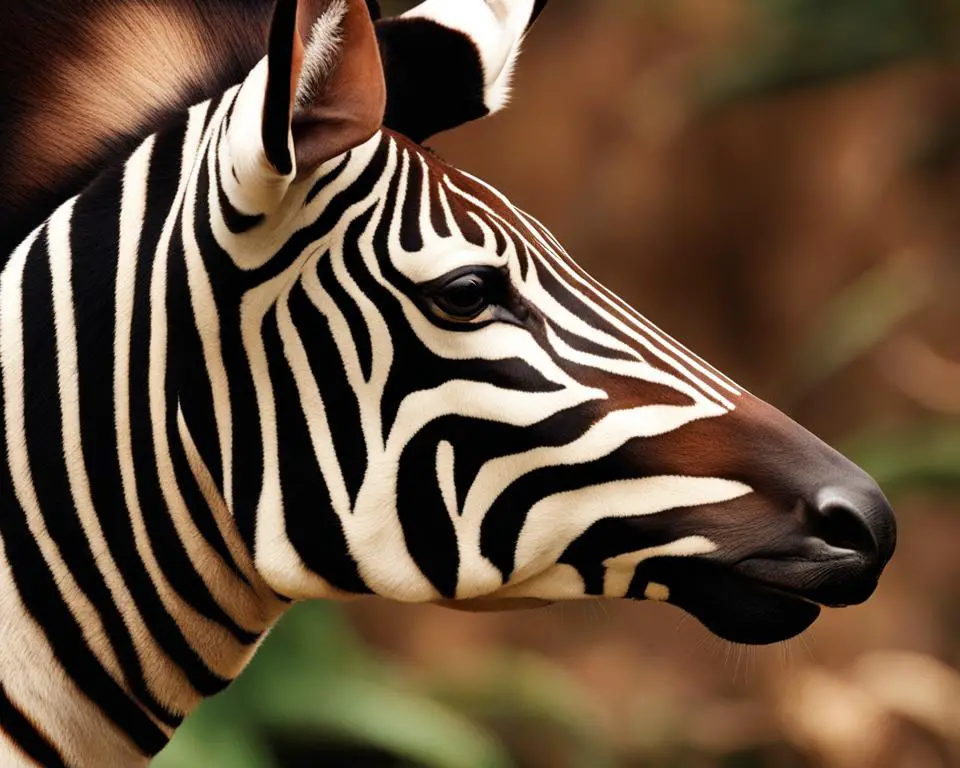
But the benefits of the okapi’s fur extend beyond its ability to repel water. Dive further into the particulars of this evolutionary marvel with the following insights on the okapi’s remarkable pelt:
| Feature | Function | Benefit |
|---|---|---|
| Dense Velvet Texture | Insulation | Regulates body temperature in fluctuating rainforest climates. |
| Oil Secretion | Waterproofing | Keep skin and fur dry in humid, wet environments. |
| Dark Coloration | Camouflage | Helps blend into the rainforest shadows, evading predators. |
These details are not merely facts to be admired; they resonate with the call of the wild, the unspoken vows of nature to preserve and protect her brood. To observe an okapi’s fur is to witness a masterclass in rainforest adaptation, a living example of what it takes to thrive in one of the planet’s most vibrant ecosystems. Whether it’s the softness that ensnares the touch or the practicality that marvels the mind, the okapi’s fur is a testament to nature’s brilliant design.
Discovery and Documentation: The Okapi’s Reveal to Science
The okapi, with its cryptic charm and unusual appearance, is no stranger to the indigenous peoples of the Ituri Forest. For centuries, this forest-dweller has roamed the shadowy underbrush of the Congo basin, known but uncharted within the annals of global scientific knowledge. But as history turned the page to the 20th century, the okapi’s existence would travel from indigenous legend to scientific annals, igniting a fascination that would span decades.
From Indigenous Knowledge to Global Awareness
Long before the creature known as the okapi captured the scientific community’s imagination, it was a familiar part of the everyday life within the dense flora of the Ituri Forest. However, to the outside world, it remained shrouded in mystery—a rumored African unicorn that tantalized explorers and sparked curiosity across continents. The indigenous narratives and knowledge of this elusive herbivore inevitably paved the way for its global recognition.
First Documented Sightings and Recognition
It took the tenacious curiosity of Harry Johnston, a British explorer, to deliver the tangible evidence of the okapi to Western scientists. In 1901, after obtaining a skin and skull from the Ituri Forest depths, Johnston dispatched these items, bridging the gap between myth and scientific discovery. Yet, for over a century, this inception would only scratch the surface, as the truest testament to the okapi’s secretive life—the first wild okapi photo—wouldn’t be taken until 2008, underlining the extraordinary elusiveness of this remarkable species.
A Glimpse into the Okapi’s Diet: More Than Just Leaves
As you venture into the dietary world of the okapi, you will find that their eating habits reveal much about the complexity of their rainforest ecosystem. Far from being a simple forager of foliage, the okapi’s diet reflects a careful balance of nutrient intake crucial for their survival.
The Significance of a Prehensile Tongue
The okapi is a masterful herbivore with a prehensile tongue that is not only remarkable in length but also exceptional in functionality. Capable of extending up to 14 inches, this muscular appendage is essential for grasping and stripping leaves, demonstrating the plant diversity within the okapi’s diet. This tongue’s dexterity aids in their dietary habits, allowing them to select specific vegetation from the multitudes available in their habitat.
An Unusual Appetite for Clay and Guano
Beyond the lush green leaves, okapis have developed an interesting facet in their dietary repertoire. Their penchant for clay and bat guano underscores their dependence on varied nutrient intake. Consuming these substances provides a rich source of minerals that may be lacking in their primary diet, highlighting the adaptive nature of the okapi’s feeding behavior and underscoring the importance of maintaining a diverse habitat for their continued health.
Here’s how the okapi diet contributes to their overall well-being in a table format that illustrates the role of key items in their nutrition:
| Dietary Item | Purpose | Nutrients Provided |
|---|---|---|
| Leaves and Buds | Primary food source | Fiber, Proteins |
| Fruits and Berries | Energy provision | Vitamins, Sugars |
| Clay | Mineral supplementation | Calcium, Sodium |
| Charcoal | Toxin adsorption | Activated Carbon |
| Bat Guano | Uncommon nutrient source | Phosphorus, Potassium |
As you can see, the okapi diet is a testament to their ability to utilize the biodiversity of their environment. The varying components of their diet assist in maintaining their distinctive physique and boosting their immune systems, making them a fascinating subject for understanding the intersection of herbivore diets and rainforest ecology.
Communication Tactics and Social Interactions of Okapis
Imagine strolling through the Ituri Rainforest and hearing a series of soft sounds—a cough or a whistle. These subtle okapi sounds are part of the rich tapestry of social behavior observed in these solitary creatures. But there’s more to their communication than what meets the ear. Beneath the audible surface lies a world of infrasonic communication, invisible to human hearing but fundamental to okapi life.
As a connoisseur of wildlife wonders, you may be intrigued to learn about the sophisticated soundscape that okapis inhabit. Their repertoire of communication extends from the familiar to the phenomenal, with the power of infrasound playing a pivotal role in their secretive exchanges.
Scientists have uncovered this phenomenon, revealing an intricate system designed for survival, allowing okapis to communicate over long distances and through dense forest. This tactic is particularly crucial for mother okapis. By emitting infrasonic calls, they expertly keep in touch with their calves without alerting predators like leopards. Consider the following table that encapsulates the okapi’s fascinating array of sounds:
| Okapi Communication Type | Observation |
|---|---|
| Coughs | Common among okapis when signaling each other in the dense forest. |
| Bleats and Whistles | Usually emitted by calves and during breeding to facilitate location and interaction. |
| Infrasonic Sounds | Used by mothers to communicate with their offspring; undetectable to the human ear and keeps communication covert from predators. |
While they may lead mainly solitary lives, okapis still engage in social interactions, particularly during the mating season or when mothers bond with their young. These interactions are vital for the perpetuation of their species, and sound plays a critical role in facilitating these connections.
As you reflect on the mysterious world of the okapi, consider the sophistication inherent in their communication strategies. They remind us that silence in the forest is not an absence of dialogue but a conversation happening on a different frequency. Understanding the nuances of such social behavior is integral to our appreciation and conservation efforts for these enigmatic forest dwellers.
Conservation Status: The Struggle Against Declining Numbers
The enchanting okapi, with its velvety fur and conspicuous stripes, confronts a grim reality as an endangered species. Residing in the dwindling rainforests of the Democratic Republic of Congo, these members of the Giraffidae family are facing an uphill battle against habitat loss and the pressing threats presented by human expansion. With the International Union for Conservation of Nature (IUCN) ringing alarm bells, it is imperative for you to grasp the gravity of the okapi’s plight.
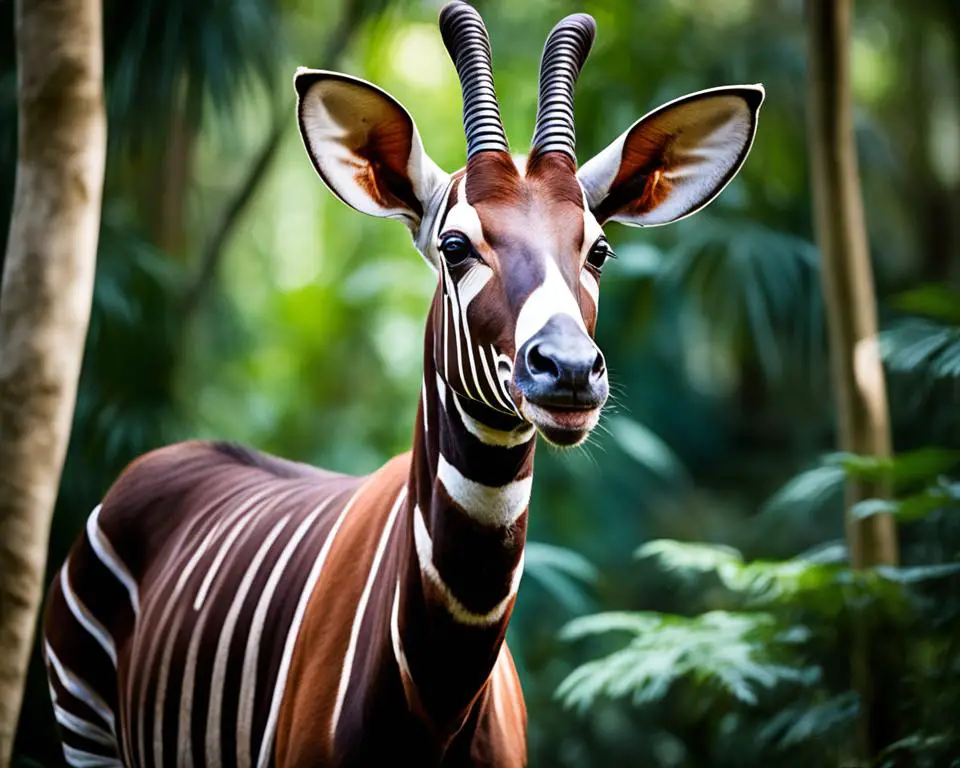
Current population estimates of the wild okapi fluctuate between 10,000 and 30,000 individuals, a figure drawn from the best available data but fraught with uncertainties. The challenges of conducting comprehensive surveys in their remote habitats mean these numbers could be optimistic at best, or heartbreakingly low at worst. Confronted by deforestation, conflict, and illegal activities in their home range, okapis exemplify the dire consequences of an ever-shrinking natural world.
Researchers believe that in the last 25 years, we may have lost half of the okapi population—an alarming rate that reflects the extensive habitat loss and pervasive human encroachment within the Congolese rainforest.
Here is a closer look at the forces that critically endanger these remarkable creatures and the conservation status reflecting their uphill struggle for survival:
| Threat | Impact on Okapi | Conservation Status |
|---|---|---|
| Deforestation | Destroys essential habitat, limiting resources and space | Endangered (IUCN) |
| Illegal Mining | Disrupts ecosystems, contaminates water sources | Endangered (IUCN) |
| Poaching | Directly decreases populations through unlawful hunting | Endangered (IUCN) |
| Human Settlement | Fragmentation and degradation of habitat | Endangered (IUCN) |
As stewards of this planet, your awareness of okapis’ predicament is vital. Facing a tenuous future marked by the perils of habitat loss and the pressures of human interaction, the conservation community, guided by IUCN directives, is mounting concerted efforts to halt the decline in okapi numbers. The continuation of this species relies not only on dedicated conservation measures but also on a profound shift in how we interact with and impact their primeval forests—the only home they know.
Contributing to Okapi Conservation Efforts and Sustainable Practices
Embarking on the journey to protect the enigmatic okapi begins with understanding the critical importance of wildlife conservation and sustainability. As you ponder ways to support these awe-inspiring creatures, consider how advocacy, informed choices, and commitment to sustainable practices can substantially impact the preservation of the okapi and its habitat.
Supporting the Okapi Wildlife Reserve
One way to champion the cause of the okapi is through robust support of the Okapi Wildlife Reserve. This bastion of biodiversity is not just an animal refuge; it’s a World Heritage site that represents an essential piece in the ecological mosaic of the Congo Basin. By backing sustainable livelihood programs within the reserve, you ensure that local communities are empowered, fostering a relationship of mutual benefit between human residents and the wildlife that calls this lush expanse home. Your support of Okapi Wildlife Reserve sustainability initiatives sends a clear message: the conservation of these precious ecosystems is a shared global responsibility.
Responsible Choices in Gold Purchasing and Electronics Recycling
On a more individual scale, making intentional choices about your purchases can lead to a significant ripple effect. Opting for conflict-free gold when acquiring jewelry not only promotes ethical mining practices but also safeguards against the environmental devastation that accompanies illegal mining operations—activities that all too often encroach upon the okapi’s natural habitat. In the same vein, prolonging the use of electronic devices and committing to proper recycling can curb the demand for coltan, an ore extracted from rainforest regions critical to okapis. Such choices contribute to a larger culture of wildlife conservation, combating the dire threats posed by habitat loss and degradation.
Your role in wildlife conservation, specifically in supporting the Okapi Wildlife Reserve, extends beyond avid advocacy. It encompasses responsible stewardship in your everyday choices—a testament to your dedication to safeguarding the sustainability of our planet’s diverse species and the myriad of environments they inhabit. Together, we can ensure that future generations will still be captivated by the stealth and beauty of the forest giraffe.
Physical Characteristics Defining the Okapi
Step into the world of the okapi, where the amalgamation of distinctive markings and a stance reminiscent of both equine grace and giraffe elegance create an animal of unique beauty. These forest-dwelling beings, with their velvety coats and cryptic color patterns, stand as a testament to the diversity of nature. As we delve deeper into their physical features, it’s evident that the okapi appearance is an evolutionary canvas, painted with strokes of survival and adaptation.
Unique Physical Traits Distinguishing It from Other Mammals
The okapi’s aesthetic is a montage of nature’s artistry, from its long neck to the zebra-like stripes ornamenting its legs. These distinctive markings serve not just for allure, but as camouflage, blurring the lines between animal and habitat. The presence of ossicones—horn-like structures—on the males and their absence on females illustrate a clear case of sexual dimorphism, where the two sexes bear differing characteristics beyond their reproductive organs.
Impressive Size and Weight Stats
A symbol of both strength and gentleness, the okapi stands tall with a length reaching up to eight feet. Weighing in between 440 to 660 pounds, these creatures own their space in the rainforest with silent confidence. Given their considerable size, the okapi deftly navigates the dense underbrush of its environment, reflecting a majesty unique to this species.
Their substantial build, paired with their ability to blend seamlessly into the undergrowth, reveals the okapi’s commanding presence—a gentle giant of the forests it calls home. Understanding the size and weight of these animals also highlights their food requirements and the vastness of the territory they require to sustain such magnificent frames.
| Physical Feature | Description | Sexual Dimorphism Exhibit |
|---|---|---|
| Size | Up to 8 feet in length | Similar between sexes |
| Weight | Between 440 to 660 pounds | Similar between sexes |
| Ossicones | Horn-like structures | Present in males, absent in females |
| Coat | Velvety, dark purple to reddish-brown | Similar between sexes |
| Leg Stripes | White horizontal stripes | Similar between sexes; unique pattern per individual |
As you envision the okapi in its natural setting, consider these distinct physical attributes not merely as quirks of genetics but as vital aspects of survival. Every stripe, every curve of their body speaks to the adaptability and perseverance of the okapi, a creature both enigmatic and endearing in its splendor.
The Daily Life of an Okapi: Behavior and Reproduction
As you delve into the world of okapis, you’ll find that these creatures lead a life dictated by their intuitive okapi behavior patterns. Unlike the more social members of the animal kingdom, okapis exhibit a solitary lifestyle, coming together primarily for breeding purposes or when participating in occasional communal feeding sessions. In the dense forests they call home, their existence is a dance of subtlety and survival.
In the vast expanse of their habitat, okapis leave behind distinct territorial markings. These secretions, sticky to the touch, alongside purposeful sprays of urine, form the silent language of okapi territory, a scent-rich canvas of ownership and boundaries. This penchant for territory hints at the intricate subtleties of okapi behavior that encourage the survival of the species.
When it comes to reproduction, the okapi’s reproductive cycle plays out in a slow, measured rhythm. With a gestation period spanning 14 to 16 months, the female okapi prepares for a single birth. Upon arrival, the okapi calf quickly takes charge of its limbs, standing and walking within a mere thirty minutes—a testament to the resilience and immediacy of life in the wild.
Okapis may not be chatty creatures—vocalizations among adults are few and far between, typically reserved for moments of attraction during mating season. Yet, the mother and calf communicate through a unique channel of infrasonic sounds. These sounds, undetectable to the human ear, create a silent dialogue that maintains the connection without alerting lurking predators.
Reflecting on the mother’s maternal instincts, you’ll observe an impressive dedication to the safety and upbringing of the young until independence is asserted around six months of age. After which, the calf will begin its own journey of solitary living, and the cycle of the okapi behavior will start anew.
Let’s take a closer look at the essential aspects of okapi behavior and their reproductive cycle through this detailed table:
| Behavioral Aspect | Details | Role in Survival |
|---|---|---|
| Territorial Markings | Okapis use sticky secretions and urine to demarcate their domain. | Serves to establish personal space and reduce conflicts. |
| Gestation Period | Lasts approximately 14 to 16 months for a single calf. | Ensures the birth of a well-developed, robust calf. |
| Calf Development | Newborns are able to stand and walk within minutes after birth. | Allows quick adaptation to the environment for survival. |
| Maternal Communication | Infrasound communication between mother and calf. | Keeps calf close and safe without attracting predators. |
| Solitary Lifestyle | Okapis spend most of their life alone, barring breeding season. | Reduces risk of predation and resource competition. |
The life of an okapi, from its solitary meanderings to the tenderness of maternal care, offers a glimpse into the balance of life within the rainforest. Whether marked by their solitary footprints or the invisible threads of infrasonic calls, the daily life and reproductive cycle of the okapi are a wonder to behold, a rich narrative of survival against the odds.
Recognizing the Natural and Human-induced Threats to Okapis
As you acquaint yourself with the challenges facing the okapi’s survival, it becomes clear that their continued existence is jeopardized by both natural and human-induced threats. In the dense rainforests they inhabit, the interplay of environmental threats and human wildlife conflict constructs a precarious situation for these unique animals. Let’s peel back the layers to better understand these pressing conservation challenges and how they impact the future of okapis.
Predation by Leopards as a Natural Threat
Among the natural threats that loom over the okapi, leopards stand out as the primary predator. These graceful, yet formidable hunters are native to the same habitat and, in the wild, they pose a significant risk to the okapi population. Effective as they are in their camouflage, okapis sometimes fall victim to the predator’s prowess, contributing to the challenges of maintaining stable population numbers in their natural environment.
Human Impacts: Hunting, Habitat Loss, and More
Further complicated by anthropogenic pressures, the okapi’s struggle intensifies with the specter of habitat loss. Deforestation for logging and human settlement fragments the okapi’s lush domain, unraveling the fabric of an ecosystem that has supported them for millions of years. Unlawful poaching for bushmeat and skin, along with the impact of illegal mining operations, not only diminishes their numbers but also degrades the quality of their habitat. And not to be underestimated, the surge of illegal armed groups within and around conservation areas severely hampers efforts to monitor and protect these creatures. The siren of urgent action sounds off against these environmental threats, summoning a collective and robust response to alleviate the human wildlife conflict and ensure the okapi’s rightful place in the rainforest remains secure.

